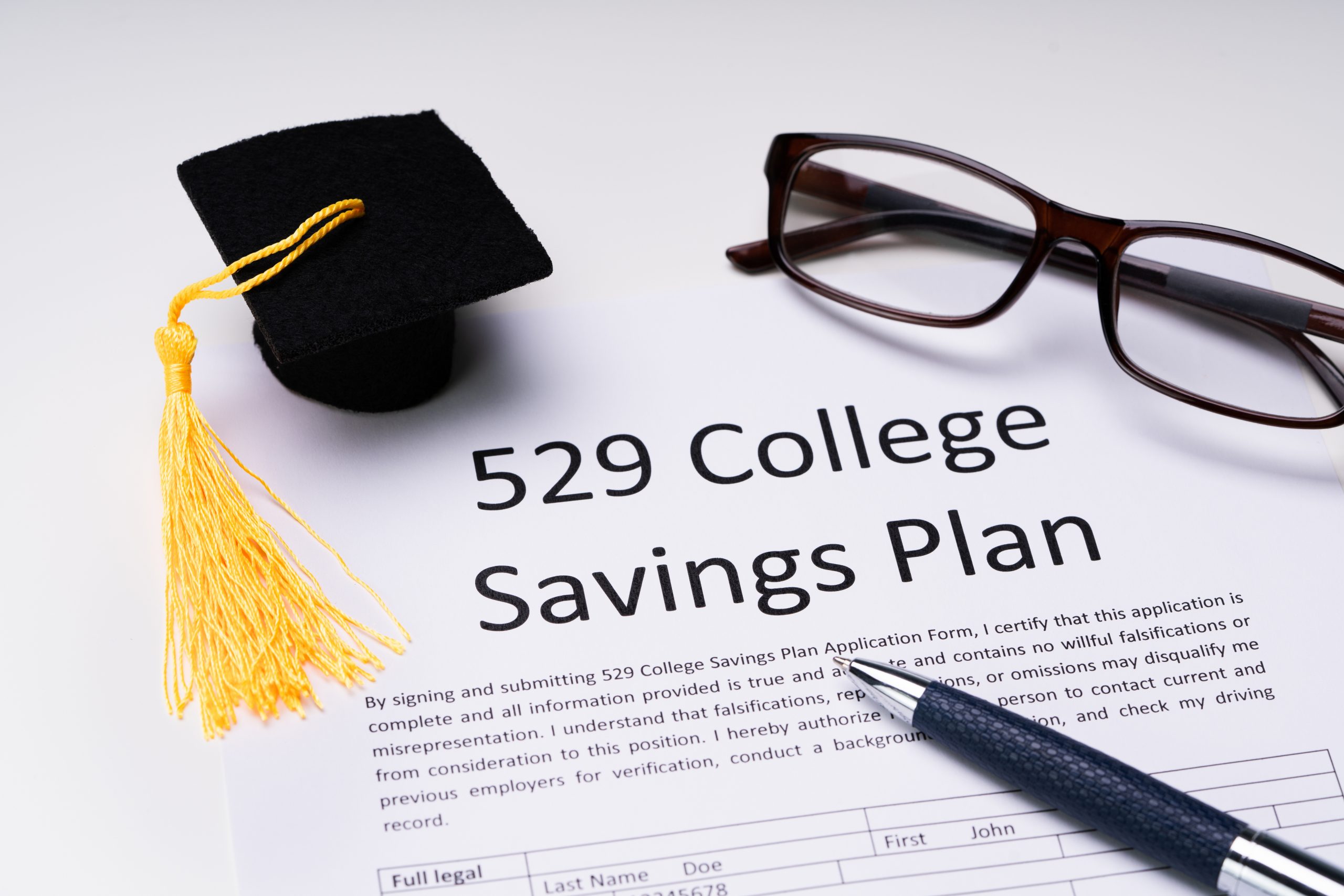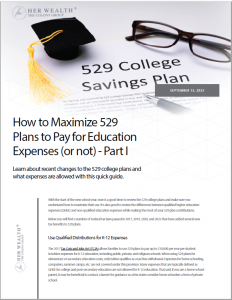How to Maximize 529 Plans to Pay for Education Expenses (or not) – Part I
Learn about recent changes to the 529 college plans and what expenses are allowed with this quick guide.
With the start of the new school year, now is a good time to review the 529 college plans and make sure you understand how to maximize their use. It’s also good to review the differences between qualified higher education expenses (QHEE) and non-qualified education expenses while making the most of your 529 plan contributions.
Below you will find a number of Federal tax laws passed in 2017, 2019, 2020, and 2022 that have added several new tax benefits to 529 plans.
Use Qualified Distributions for K-12 Expenses
The 2017 Tax Cuts and Jobs Act (TCJA) allows families to use 529 plans to pay up to $10,000 per year per student in tuition expenses for K-12 education, including public, private, and religious schools. When using 529 plans for elementary or secondary education costs, only tuition qualifies as a tax-free withdrawal. Expenses for home schooling, computers, summer camps, etc. are not covered under this provision. Many expenses that are typically defined as QHEE for college and post-secondary education are not allowed for K-12 education. That said, if you are a home school parent, it may be beneficial to contact a lawyer for guidance as a few states consider home schoolers a form of private school.
Rollover Funds to an ABLE Account
The 2017 TCJA also allows account holders to make tax-free rollovers from traditional 529 plans into 529 Achieving a Better Life Experience accounts (ABLE) in the event the beneficiary becomes disabled. To qualify for a 529 ABLE account, individuals must have been diagnosed with a significant disability before they reach the age of 26 and the condition is expected to last 12 consecutive months or more. The individual must also be receiving Supplemental Security (Disability) Income (SSI/SSDI) benefits or be able to obtain a disability certification from a doctor. ABLE accounts offer tax-free investment growth and withdrawals when the funds are used to pay for qualified disability expenses such as education, job training, healthcare, and financial management. Total contributions from all sources are limited to the annual gift tax exclusion each year ($17,000 in 2023). It is important to keep in mind that if a person’s ABLE account balance exceeds $100,000, they will no longer be eligible for SSI benefits but may still receive Medicaid.
Pay Off a Portion of Student Loan Debt
The 2019 Setting Every Community Up for Retirement Enhancement (SECURE) Act made it so a lifetime maximum of $10,000 per individual from 529 proceeds can now be used to pay off a portion of student loan debt.
Rollover to Roth IRA
The SECURE 2.0 Act of 2022 introduced a new rule that starting 2024, a lifetime maximum of up to $35,000 can be rolled over from a 529 plan to a beneficiary’s Roth IRA; however, some rules apply:
• Annual Roth IRA contribution limits apply to rollovers ($6,500 limit in 2023), meaning it would take six years to convert $35,000 from a 529 plan to a Roth IRA).
• Conversions can only be made to a beneficiary’s Roth IRA; a parent saving with a 529 plan in a child’s name cannot shift unused funds back into their own retirement account.
• Rollovers are not allowed until a 529 account has been open for a minimum of 15 years.
• Funds converted from 529 plans to Roth IRAs remain in the account for at least five years.
QHEEs versus Non-Qualified Expenses
As long as 529 plan withdrawals are used for QHEE during the year in which they are withdrawn, account earnings are tax-free. If money from a 529 plan is used for anything that does not meet the “qualified expense” criteria, the earnings portion of that non-qualified distribution will be taxed as ordinary income and subject to an additional 10% penalty. There are exceptions to the 10% penalty rule such as the beneficiary becoming disabled, attending a U.S. Military Academy, or being awarded a scholarship. Keep in mind that the principal portion of any withdrawals – your after-tax contributions – will never be taxed or penalized.
529 Qualified Expenses (QHEEs)
• Tuition: For full-time and part-time students at an accredited institution.
• Room and Board: On-campus/dormitory room and board is a qualified expense. Off-campus housing and meal costs are eligible up to the college’s published allowances in their “cost of attendance” figures, typically found on the school’s website or financial aid office. 529 funds used to pay for rent or meals in excess of the allowances published by the college’s annual cost of attendance are not a qualified expense.
• Fees: All fees, such as lab and technology fees, required by the school.
• Books and Supplies: Required textbooks, lab supplies, and basic supplies including pens, paper, printer ink, etc. are qualified expenses.
• Technology: Computers, iPads, printers, internet service, and required educational software used by the 529 beneficiary while enrolled in college are qualified expenses.
• Additional expenses of special needs beneficiaries: Certain services and equipment that a special needs student would require such as wheelchairs and/or transportation costs, are typically considered a non-qualified expense and are eligible.
529 Non-Qualified Expenses
• Transportation and Travel: You cannot use 529 funds for transportation of any kind including airfare, gas, and certainly not to purchase a car as your primary means of transportation to and from college. This includes travel for move-in/out purposes, holidays, etc.
• Insurance: Health insurance and medical services, even though they may be billed by the university, are not a qualified education expense.
• Student Loan Repayment: Previously, you could not use 529 funds to repay any of your student loans, but under the 2019 SECURE Act, account holders may now use their 529 plans to pay off up to $10,000 in student loan debt. Make sure you use as much of your 529 savings to pay for your college expenses up front to avoid taking out unnecessary loans.
• Cell phones and other electronics: Cell phones, cell phone plans, and electronics for personal use are not eligible.
• Fitness club and activity fees, including fraternity and sorority membership dues: All of these expenses are considered extracurricular (non-educational) and not eligible.
• Lifestyle and personal expenses: Mini refrigerators, laundry, and personal expenses are all not eligible.
If your child receives a scholarship, you essentially have three options for your 529 plan:
- Use the 529 plan for qualified expenses not covered by the scholarship, including graduate school in the future.
- Direct the 529 to another family member-beneficiary such as a sibling.
- Withdraw the amount of the tax-free scholarship from the 529 plan, penalty-free, and pay income tax on any earnings.
Thanks to recent changes in the tax law, 529 plans are no longer use it or lose it and can be used for expenses previously not allowed. This means that your 529 plan is flexible and can change with your needs and life changes. You can now use 529 plans to for K-12 education, rollover the funds to an ABLE account if needed, pay off a portion of student loan debt, and starting in 2024 there will be an opportunity to rollover unused 529 funds to a Roth IRA. When you are looking to access 529 plans you should reach out to your advisor or a CPA to ask any questions you have about maximizing 529 plans not just for post-secondary education.


